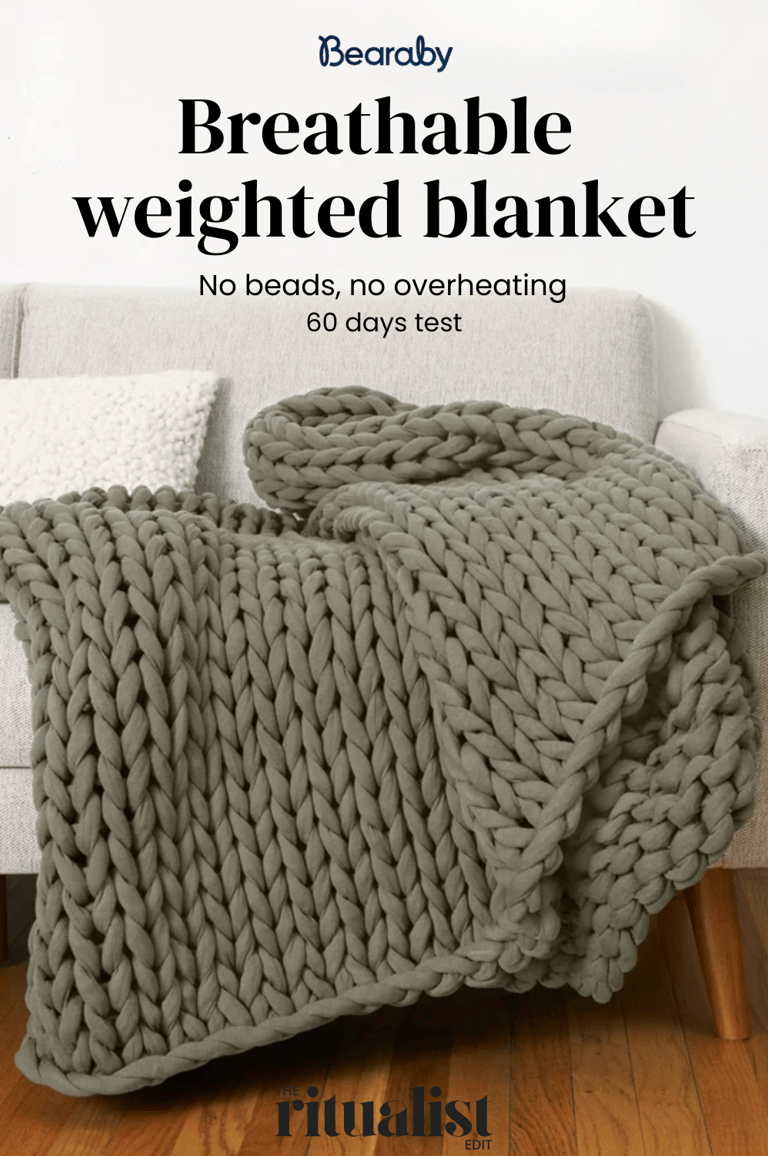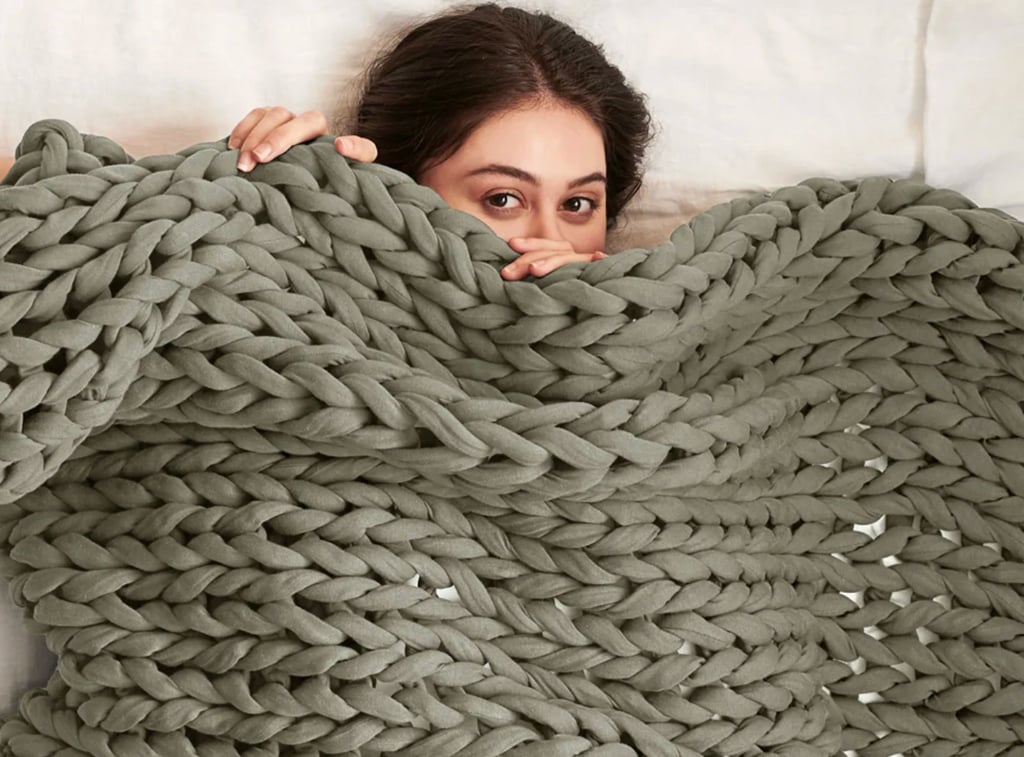The Bearaby Tree Napper: 60 Days Later
Two months ago, I promised a real-world test of Bearaby's $300 eucalyptus weighted blanket. The question wasn't whether weighted blankets work (they do), but whether this specific one could justify replacing a perfectly functional duvet. Sixty days in, the duvet is still folded at the bottom of the wardrobe.


I wasn't looking to fix my sleep. I thought my sleep was fine. Sure, I woke up at 3am most nights peeling myself off the mattress, overheated and irritated. And yes, it took 45 minutes of phone scrolling to actually fall asleep. But didn't everyone deal with that?
The Bearaby Tree Napper arrived in March as an experiment, not a solution. At $300 for what looks like an oversized knitted throw, it needed to prove itself against a duvet I'd owned for three years and never questioned. Two months of daily use later, I've stopped questioning the blanket. I'm questioning why I tolerated the duvet for so long.
We first mentioned this blanket in our Sunday Reset essentials roundup, where we promised a proper 60-day test. This is that review: Sunday Reset That Sticks: 8 Essentials We Actually Use.
What You're Getting
The Tree Napper is a weighted blanket, but not in the traditional glass-beads-sewn-into-pockets way. The weight comes from the material itself. Layers of eucalyptus-derived Tencel (Bearaby calls it "Tree" fibre) are hand-knitted into a chunky, open-weave design. No filling. No inner liner. No sections that shift or bunch when you move.
Here's where Bearaby does something clever: they've built a calculator on their website that determines both the weight and size you need based on your body, not your bed. The principle is 10% of your body weight. At 86kg, the calculator recommended a 6.8kg blanket in 107x183cm. The price adjusts based on what you need. For my measurements, that's $249. Heavier weights and larger sizes push closer to $350.
This body-focused sizing explains why the blanket doesn't cover your entire mattress. It's designed for one person to lie under, creating what Bearaby calls Deep Touch Pressure. The weighted coverage on your body is what triggers the calming response, not having every inch of the bed covered.
The eucalyptus option is specifically for people who overheat. Bearaby also makes cotton and velvet versions, but if you're someone who wakes up hot, those aren't relevant. The Tree version is the cooling one.


Week One: Adjustment Period
The first night felt strange. Not bad, just unfamiliar. The weight pins you in place differently than a duvet. You're aware of it for the first 10 minutes, and then your nervous system seems to accept it and move on.
Night three, I realised I hadn't rearranged the blanket once. Usually I'm pulling the duvet up over my shoulder, shoving it down when too warm, bunching it under my chin. The Tree Napper stays where you put it. You stop fiddling with it, which means you stop half-waking to adjust things.
My partner tried it for two nights and handed it back. "It's like being held down," he said. He's restless, shifts positions every hour, needs freedom to move. For him, 6.8kg was oppressive. For me (a still sleeper who barely moves once I'm horizontal), it felt grounding rather than restrictive.
The Temperature Question
This was my main concern. Weighted blankets have a reputation for trapping heat. The last thing I needed was more warmth when I was already waking up overheated.
The eucalyptus fibre works differently than cotton. Cotton absorbs moisture and holds it. Eucalyptus-derived Tencel wicks it away from your skin. On warm nights (above 20°C), I stayed covered all night instead of kicking everything off by 2am. The open-knit design helps too. Those gaps in the weave aren't just aesthetic, they allow actual airflow.
We had a cold snap in late March (around 6°C overnight). I expected to need my duvet back. I didn't. The weight creates enough of a microclimate that you stay comfortable without overheating. It's not cosy in the duvet-cocoon sense. You just stop thinking about temperature entirely.
By week four, I'd stopped checking if I was too hot or too cold before falling asleep. That mental negotiation just disappeared.
What Changed (That I Wasn't Expecting)
I bought this to sleep better. The actual shift was in how I ended my day.
By week three, getting under the Tree Napper had become the marker between working hours and rest. I work from home. My laptop lives in the bedroom. Clients are in different time zones. The boundary between available and unavailable has always been fuzzy.
The blanket created a physical threshold. Once I was under it, I wasn't checking emails. I wasn't "just quickly" looking at one more thing. This sounds like I'm giving too much credit to a blanket, but the weight and texture signal something distinct. A duvet is invisible, automatic. This is foreground. You notice getting under it.
Sleep onset time improved too. Most nights now, I'm asleep within 15 to 20 minutes of lying down. Before, that number was closer to 45 minutes of reading, scrolling, general brain negotiation. The weight seems to short-circuit the scrolling reflex entirely.
The Practical Reality
I washed it twice during the 60 days (once at week three, once at week seven). Cold cycle, laid flat to dry. It took about eight hours to dry completely. A traditional weighted blanket with glass beads takes two days and usually needs a commercial dryer.
The knit can snag. Week five, I caught a loop on my watch clasp. It pulled slightly but didn't unravel. You need to be conscious of jewellery, rings, anything with edges. Not a dealbreaker, just something to be aware of.
It's heavy to move. This sounds obvious (weighted blanket, it's in the name), but 6.8kg of eucalyptus knit is genuinely cumbersome. I'd planned to bring it to a weekend away and gave up trying to fit it in a bag. It stays home.
The size took adjustment. At 107x183cm, it doesn't tuck under the mattress. If you're someone who needs bedding that folds under and stays hospital-cornered, this will feel wrong for the first week. It sits on top like a throw. I got used to it. My partner never did.


The Cost Reality
At $249 to $350 depending on your size and weight needs, the Tree Napper costs about the same as a premium down duvet or a mid-range weighted blanket with glass beads and a cotton cover.
Per night over two years: $0.34 to $0.48 per night.
Alternatives worth considering:
Simba Orbit Weighted Blanket ($220 for 6.8kg): Cotton cover with glass beads. Less breathable, but potentially cheaper depending on your size needs. Good option if you're testing whether weighted blankets work for you at all.
Gravity Weighted Blanket ($200 for 9kg): Poly-pellets, quilted design, machine washable. Does the functional job without the aesthetic element. More practical, less of a ritual object.
Budget option: Weighted blankets exist at $80 to $100, but they use materials that pill, beads that shift, covers that don't breathe. If you're testing the concept, start there. If you know you want this specific experience, save the extra money.
Who This Is For
Buy it if:
You sleep hot and have given up on duvets between May and September
You're a back or side sleeper who stays relatively still at night
You work from home and struggle with end-of-day boundaries
The bed is visible in your space and you care what it looks like
Start with a cheaper option if:
You've never tried a weighted blanket and aren't sure it works for you
You need something fully machine washable with no special care
You move around constantly at night
Skip it if:
You change positions multiple times per night and need freedom to move
You run genuinely cold and need insulation over breathability
You want something portable for travel (too heavy, too bulky)
The Verdict
Week eight, and I'm still using it. Not as a test. As the default.
The duvet came out once in mid-April when we had an unusually cold week. I lasted two nights before switching back. The surprise wasn't that weighted blankets work (that's well established). The surprise was that this specific design solved problems I didn't realise I had. I wasn't just overheating. I was also dealing with bedding that required constant adjustment and didn't mark any kind of transition into rest.
The Tree Napper looks like something you chose deliberately. That distinction, small as it sounds, changed how I approached going to bed.


